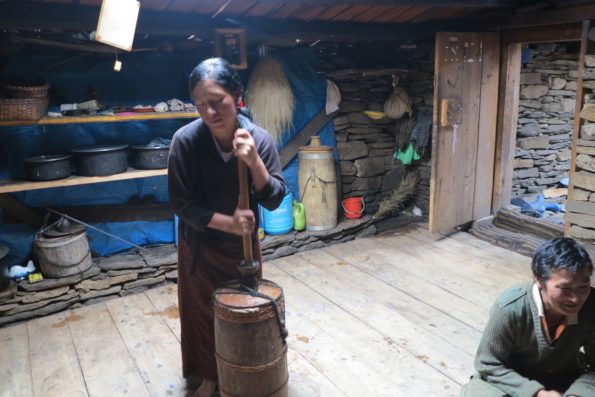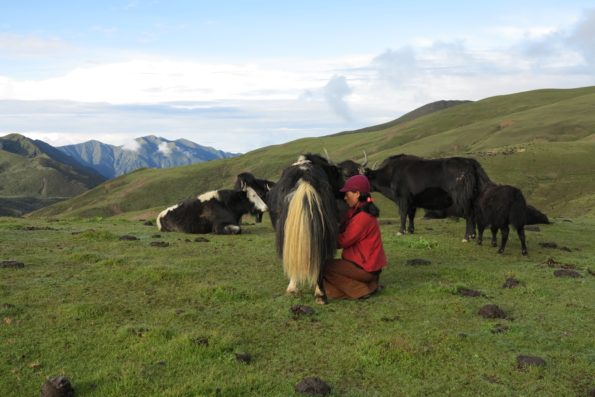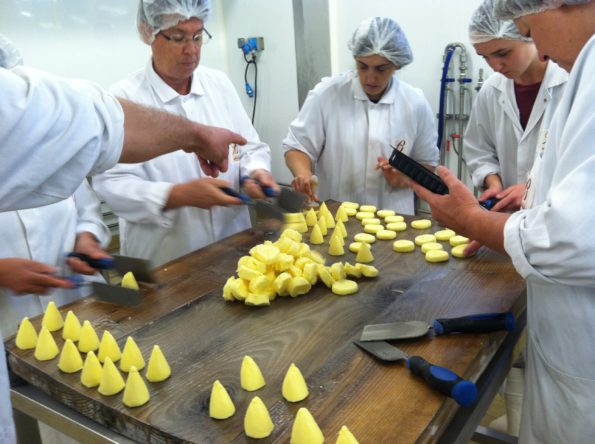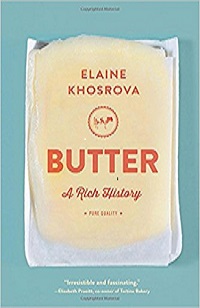The story of butter and the story of us.
“Behold, our butter stinketh!—Give us, therefore, butter that stinketh not,” was what Henry Thoreau’s grandfather Asa Dunbar proclaimed in 1766 in Harvard. This was the first student protest in American history, and while it was about butter, it implicated the declining state of food in the university’s dining halls.
It seems rather incredulous if you think about this way- ages ago (we are talking sometime in the Neolithic era), a serendipitous accident of milk stored in an animal skin bag, rocked back and forth through its journey led to butter- the protagonist in the first known student protest. Elaine Khosrova’s book Butter; A Rich History places this protagonist at the centre of many significant events in history which had a much larger impact than food in dining halls. If Julia Child made us fall in love with butter, Khosrova makes us look at it with reverence and sometimes flinch a little considering how misunderstood it is. Butter truly deserves better!!
Khosrova takes us on a journey as she writes about Yak butter from Bhutan, butter from water buffalo’s milk which she tasted in Punjab, Tibetan butter sculptures, a butter artefact collector’s treasures in New Jersey, the famous Le Beurre Bordier butter in France, Swedish butter maker Patrik Johansson and so much more. From a happy accident to a magical concoction which only dairy maids could get right, to being avoided or replaced by cheaper (and lesser healthy) alternatives- it looks like butter has had quite the bumpy ride. With Butter’s exoneration and many artisan makers taking an interest in the product and the technique we are witnessing, what Khosrova calls a “slow butter revivalism” around us. A book that chalks butter’s past, present and future is needed now more than ever.
Elaine Khosrova on butter and it's many sides. Click To TweetElaine Khosrova has more than twenty years of experience as a pastry chef. She has a degree in Food and Nutrition and has worked as a test kitchen editor and food writer. She is the founding editor of Culture: The Word On Cheese– America’s first magazine which focuses on artisan cheese. Butter: A Rich History -is “the first and only publication (thus far) to chronicle the life and times of this beloved fat,” and has also been voted one of the best books about food for the year 2016 by Smithsonian Mag. Over Skype, Elaine Khosrova spoke to me about butter, and it’s many slippery sides.

“For the inquisitive eater who savors more than just the taste of things, butter’s story is a ticket to appreciating the mighty role a simple food can play in the course of human events.”
Before we talk about anything, you have to wonder how one would choose butter as the subject of their book? In her book, Khosrova writes about an editorial project which involved tasting butter from all over the world and somewhere sparked her interest in exploring it further. “On the tasting table were bricks of butter from as far away as New Zealand, Italy, the Czech Republic, Ireland, and France plus domestic brands from Vermont, Wisconsin, California, and places in between. At the time, the task seemed like a redundant one. Butter is so elemental, I thought, how different from one another could they really be?”
EK: It was a bit of an evolution because when I did that butter tasting, it really piqued my curiosity in the science and craft of butter making. I wanted to explore the more geeky side to understand these nuances that were in front of me- texture/colour/flavour. That quickly took me down the road of history because when you look at the evolution of butter making, there are places where it has not evolved into an industrial model- such as in parts of France. Traditional butter-making still exists in many regions. That connected me with the history, and as I went further and further back, just out of curiosity, I started to see this epic story emerge. I was astonished to find that there wasn’t a book written about it. There is so much to this story of butter that my book could have been encyclopedic and easily twice the size! I never really had the ambition to write a book. I have been magazine writer my whole life, and I like jumping around different subjects. The prospect of focusing on one subject for so long was daunting for me, and at the same time, I so fell in love with the topic. Butter has been underappreciated and demonized for a large part of the modern history.

As we look at the history of butter, we realise how multi-faceted this product has been. Playing a role in shaping spiritual and cultural practices, butter was also used for medicinal and cosmetic purposes. From the ghee used by Vedic Aryans to butter’s role in Buddhism and the first meal mentioned in the Bible, butter has been more than a dairy by-product.
EK: We just think of it as a food commodity. When I could see the whole arc of butter’s impact- politically and religiously, I realized there is so much more than the culinary aspect of butter. As I was organizing the book, I was surprised by the end that there is only one culinary chapter (the last part of the book highlights recipes). I don’t think there is another food like that. Researching for the other aspects of butter was a lot of fun. I met Buddhist priests and nuns and went to ceremonies. It was much more than sticking my nose in a book.
Butter: A Rich History, also highlights the rigid gender divide which existed in the world of dairy. Milking, making butter and cheese were considered household chores and therefore only performed by women (Khosrova emphasises that this divide continues to exist in many parts of the world even today). This was also probably the first version of what we now treasure as an artisan product. Butter varied farmhouse to farmhouse based on the equipment, the hands making it, the animal, feed, salt content etc. Dairywomen used molds/stamps and prints (butter was “patted up” in different shapes) to distinguish their work, and butter helped them to step into the world of commerce.
EK: Even if it wasn’t earning a living per say, it definitely helped them contribute to the household. They controlled the dairy arts and there was value for butter in the market. There was a certain degree of respect and status that women held. Of course, it was a lot of hard work. When butter making became industrial, I found that their life changed socially. Not only did they lose that status, they lost this world where they were involved in commerce, going to the market, and branding their butter to make it look nice. They could have this entrepreneurial spirit through butter, and that changed with industrialization. This is a bittersweet chapter because industrialization also made a high standard of butter easily available. Not all households were making good butter. There was some bad butter around. So it is bittersweet for sure.

In her book, Khosrova writes-“By any historical measure, butter’s leap to this level of industrialization from dairy-maid driven production has been remarkably quick.” While this may have had an impact on the consumer’s ability to distinguish and appreciate good butter, the scenario is slowly changing for the better.
EK: Growing up, there were maybe two kinds of butter in the market and they were identical and mass produced. But today, I can get five or six different kinds of butter in my small town. People are more intrigued for sure. For me, butter is more interesting because it’s not just the maker and the land that it comes from that matters. You have this third entity- the animal that affects the quality, the texture, and flavour of butter. These are subtle things, but they are definitely there.
The author also invests a part of the book writing about the many flaws in the diet-heart hypothesis and how butter faced the brunt of it all. As butter regains its former glory, it is back in the shopping carts, and sales have gone up world over. However for butter to be truly embraced and appreciated, it will take a generation- possibly more, Khosrova adds.
EK: I despair at times because as I went around talking about my book, people would listen to the research that I did and whats happening out there in the field of nutrition. But when it came to tasting butter after the event, they would still say things like “oh but I cant”, or “I can have only a little bit”. We are completely brainwashed against butter. Foodies naturally are inquisitive and pay more attention to the latest reports. I think they are leading this re-appreciation of butter, but it’s going to take a really long time for the attitudes to change.”

I had to ask about her favourite butter, and she answers with a laugh that this is one question she gets asked every time.
EK: One of the best butter’s I had was in Punjab in Northern India, where this family made water buffalo butter. They made it the traditional way from “dahi” and the yoghurt itself was unbelievably good. I got to taste it too. The butter just had everything going on in a beautifully balanced way. There was some sweetness, minerality, some tanginess, butteriness itself- that was astonishing. Overall I am a big fan of French butters. I know that it is clichè, but they are outstanding in my view. Vermont also makes great butter. My go-to butter is from Wisconsin that is organic pastured butter.”
We had talked about the past and the present of butter. How does butter’s future look?
EK: Consumption is going up- we know that for sure. In Europe and the United States, I think it will continue to do so. It’s also spreading to places like China and Japan as they begin to explore the dairy world. It’s interesting how butter is turning back the clock among the smaller farms. A lot of young people are taking to farming and butter is once again becoming a value-added product that will help support a farm. Butter is also rising in the food world. I am optimistic, and I feel like we have been through the darkest days. Even if it’s in the niche part of the food world -it is going to continue to be better.
Elaine Khosrova may want you to indulge in butter’s story but with the product itself, she hopes you will exercise judgement. In Butter’s pages lies a story, a history, an artistic appreciation for food and one of the most simplistic views of food and nutrition that is vastly missing from our food dialogues.
“The bottom line: We can enjoy butter in good conscience, albeit with temperance; it is, after all, rich. It does us no good to eat any fat with abandon. Nor does buttery overindulgence equate with more satisfaction. Indeed, one of the best lessons learned from my career in food and cooking is that gratification is something of a paradox: Too much of a good thing often diminishes the pleasure we derive from it.” – Elaine Khosrova, Butter: A Rich History
Similar posts which may interest you.
Sweet As Sin; The Unwrapped Story Of How Candy Became America’s Favorite Pleasure

